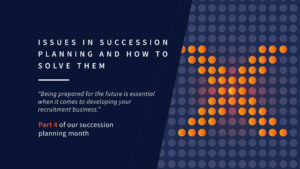‘I’ve lost 8 colleagues – every one through human failure’
When someone (Mandy Hickson sharing her story at the Recruitment Network Huddle) tells you 8 colleagues have lost their lives during the course of her fighter pilot career and every loss was a result of human failure rather than system or mechanical failure, it gets you thinking about the equivalent root cause of business failure/success (NB I am certainly not comparing the significance of lost lives to failing/succeeding at business. What’s interesting is potential impact of systems and technology on recruitment agency success or failure) To what extent is human failure – at any level – behind the successes (or failures) we see in the world of recruitment and how influential, particularly as AI evolves, is the choice and use of systems and technology we adopt? Is the proportionate human vs systems impact shifting?
It’s clear to me that it’s our ability, as business leaders, to make the right decision and effectively implement those decisions that will always have a disproportionate impact on the success or failure of our own ‘mission’. The systems, those that exist already and those that are emerging, can make us smarter, more effective and efficient, enable better candidate and client experiences, but recruitment’s still a people and relationship business and will remain so albeit with a human/tech blend behind the service proposition
How we source, engage and work with candidates is a case in point. At The Recruitment Network’s recent quarterly Huddle at the Jumeriah Carlton Tower, 160 recruitment business leaders gathered to debate, challenge and share best practice with a focus on the candidate – how to find them, engage them and deliver consistently excellent candidate experiences
Disruptive Sourcing and Candidate engagement
2 of the industry’s leading ‘sourcerers’ – Hung Lee and Mark Lundgren – joined the event and shared their observations. We polled the audience and 54% shared that not finding enough candidates was their biggest business challenge. In a recent survey of 700 recruiters interviewed, nearly 500 – in house recruiters, hiring managers and recruitment agencies – said they were candidate short.
Hung and Mark had plenty to say about how to overcome the sourcing challenges. What was clear from their research and surveys carried out (by LinkedIn and Randstad among others) was that we agree there are not enough candidates, yet we are all fishing from the same pool, LinkedIn, where it’s difficult to differentiate. We’re all doing more or less the same thing. It’s shared data and everyone is using it. If you are fishing in the same pond as everyone else, you’d better be doing something special. There is too much competition and it’s too busy so candidates are not looking on LinkedIn as much.
So there’s an overreliance on LinkedIn, what’s the solution and what can recruiters be doing differently? The solution Hung and Mark presented to The Recruitment Network membership was to better use the one unique thing that we all have: our internal data. This is data and intelligence that arguably on-one else has.
The first 15 years of this millennium was the ‘wild west’ of data: not much control, with people nicking, sharing and buying data. Anybody could capture and use your data with no legal barriers. That’s changed – it’s no longer owned by businesses but is the property of the user (hence why Facebook are currently looking to protect that data). Data is about to become very expensive (and precious – you’ll have heard of the data is the new oil concept – so we need to think about what we currently have and what we do with it.
Hung and Mark argued for a different mindset and that CRMs are not used in the right way. Currently CRM’s are used as an operational tool to capture the data, as records to access when we have a job to fill, rather than an opportunity to create communities. But changing anyone’s mindset and habits is hard. Why is that? Well for starters, recruiters are time poor, so don’t really typically speak to candidates unless we have a job for them. Recruiters work long hours and often work evenings and weekends already so it’s about bosses recognising the reality of the evolving candidate market and enabling an environment where recruiters can and want to – buy in to this is critical – work to evolve the unused database.
Can systems and technology make a difference? Of course they can:
- CRMs are evolving
- Products like Candidate ID monitors and tracks social activity to rank candidates on how likely they are to look for a job
- Chatbots capture candidate interaction and notify the recruiter that interest has been shown
Despite the systems and tech evolution, we still need to evolve the classic 360 model. The strategy of hiring more 360 consultants to make more money doesn’t create the levels of candidate engagement or community we need. 360 recruiters do too much (which is why we are not using all of the data we have) you’re a BDM, a salesperson, a researcher, candidate manager, deal closer etc. That’s a lot of work as it’s a full cycle job and consultants can be a jack of all trades, master of none.
So what else is stopping us using our unique data to create better more relevant communities? The view from the membership was that:
- No-one is actually looking at the data with the daily pressures
- Sales people are externally facing but data analysis an internally facing role
- It’s labour intensive (which is where tech can help)
- It’s a slower ROI
- Lack of confidence regarding what the content candidates really want
- The database is significant and diverse – creating the shape and structure to use it effectively
Hung and Mark pushed TRN members to embrace an Ecosystem Model – find a niche and create a community whereas a recruiter you can be at the very heart of it. Nurture the relationships within the ecosystem to keep the candidate pipeline active. Think about how we structure the company and have conversations earlier with our candidate base. Jobs are episodic. Highly skilled people want information about careers, personal development and to better themselves. That’s what we all want – to improve own knowledge and better ourselves, our teams and our business. (which as Hung pointed out is exactly what we have created at The Recruitment Network)
Sometimes the candidate engagement should be as simple as asking them, checking in every 6 months – ‘you were applying for a job last year and reach out’ – talking about career rather than a job. Become the agency that candidates come to when they have had a bad day because they trust you and you ‘get them’. Candidates are sceptical of recruitment consultants often believing they, the candidates, are a product to be sold. The intent needs to seem different, with candidates getting perceived long-term value or interest. Asking them questions, possibly linking the responses to a survey. Having different persona types on the database so you can split candidates out as they will all want different things, then writing content for each persona. For example, with in house developers, asking and writing about the struggles they face becomes content enabling the targeting of other developer candidates. Be open and ask candidates which community they would like to be a part of (e.g. construction but in the leadership pool).
Segmentation is important. It requires work but it is getting easier due to new tech options. Even without new technologies, there are other Mark Lundgrens – people who ‘geek’ out on data and enjoy identifying different persona, creating communities and bespoke approaches. There are recruitment businesses who are taking the sales pitch out of the mix by working hard to build the trusted relationship. This skill and expertise will become core and critical to sourcing.
That’s a mindset and strategy which all comes from the leadership. To what extent do we collectively buy into this concept of personas and community building. It starts with the mindset, then we need a team that is enabled – confident, trained and with time to do it – and the technology. TRN members were presented with their gift for the day ‘80 Sourcing Hacks’ – described a ‘brilliant’ by Hung Lee – shared a plethora of emerging tools and tactics.
So not only using LinkedIn as it can be used, but also understand the blend and combination of tools (ie Meetup + Google + Amazing Hiring) that can transform how effective we are at hiring. As ever with Hung, you realise the tools and numerous and evolving all the time and you really need to know your stuff and equip your consultants and resourcers with the confidence and know to embrace it. (Start with following Hung Lee’s Recruiting Brainfood – brilliant)
Katrina Collier, author and guru on candidate engagement and candidate experience expert Nicola Sullivan joined the Huddle and shared their experience of engaging candidates and standing out rather than getting lost in the crowd. They shared the research and psychology of candidate management as well as a raft of techniques to make the most of the tech and systems we all use on a daily basis.
The lessons shared confirmed Jung and Mark’s principle that while there are some great systems to embrace which can enhance the candidate journey, it’s the buy-in to the right philosophy which is so often missing. If our consultants haven’t recognised that building trust, inspiring confidence, being seen as a career partner and a community influencer is where the art of recruitment is at, they won’t embrace it. That comes from the leaders in the business and we need to invest in the training, create the environment, educate the team to understand what best practice looks like. 45% of what we do is habit and the common sourcing and candidate engagement practice – habits of the last 5 years – are not going to work moving forward.
Katrina stressed that engaging candidates required re-defining our online presence and personal brand, evolving our techniques for interacting with candidates (let’s move on from ‘urgent vacancy’, changing the language we use in our communications (‘you’ not ‘I’ etc). The psychology of the candidate engagement also needs to be understood – the fears they have, the research they will do, the support they want, the reputational damage they can cause if frustrated. Every action has a consequence and Katrina shared how to build an online presence – from your profile picture to your Google search results via Instagram. Share your passions, your testimonials, your expertise and how you treat people
TRN Member Highfield Professional Solutions is a great example of a recruitment agency success story who has worked hard to get the ‘people’ bit of running a great recruitment agency right – great people, skilled and really engaged in the business – and then making sure they use tech right to create efficiency. They have successfully embraced and invested in appropriate systems and technologies to maximise productivity and effectiveness. Equally important, and co founder Liam Thomas shared his big 3 non-negotiable principles for building his business – everyone has to embrace learning – and he’s convinced this has played a significant part in successfully building the business (they now employ 40+ and are enjoying 68% GP growth last year). That learning includes embracing best practice sourcing.
Members walked away with really practical strategies and tactics to implement in the business. It was a powerful day involving TRN members being challenged and stimulated and accessing ideas all recruitment business leaders should be on top of, but also some critical life lessons from inspirations such as Miles-Hilton Barber, who’ve experienced more than most of will ever do, and had some crazy adventures is possible. So in Miles words, Dream it. Believe it. Do it.
Let us know if you’d like to get involved with The Recruitment Network – the summer retreat is in July – contact us via ed@therecruitmentnetwork.com
Share :



